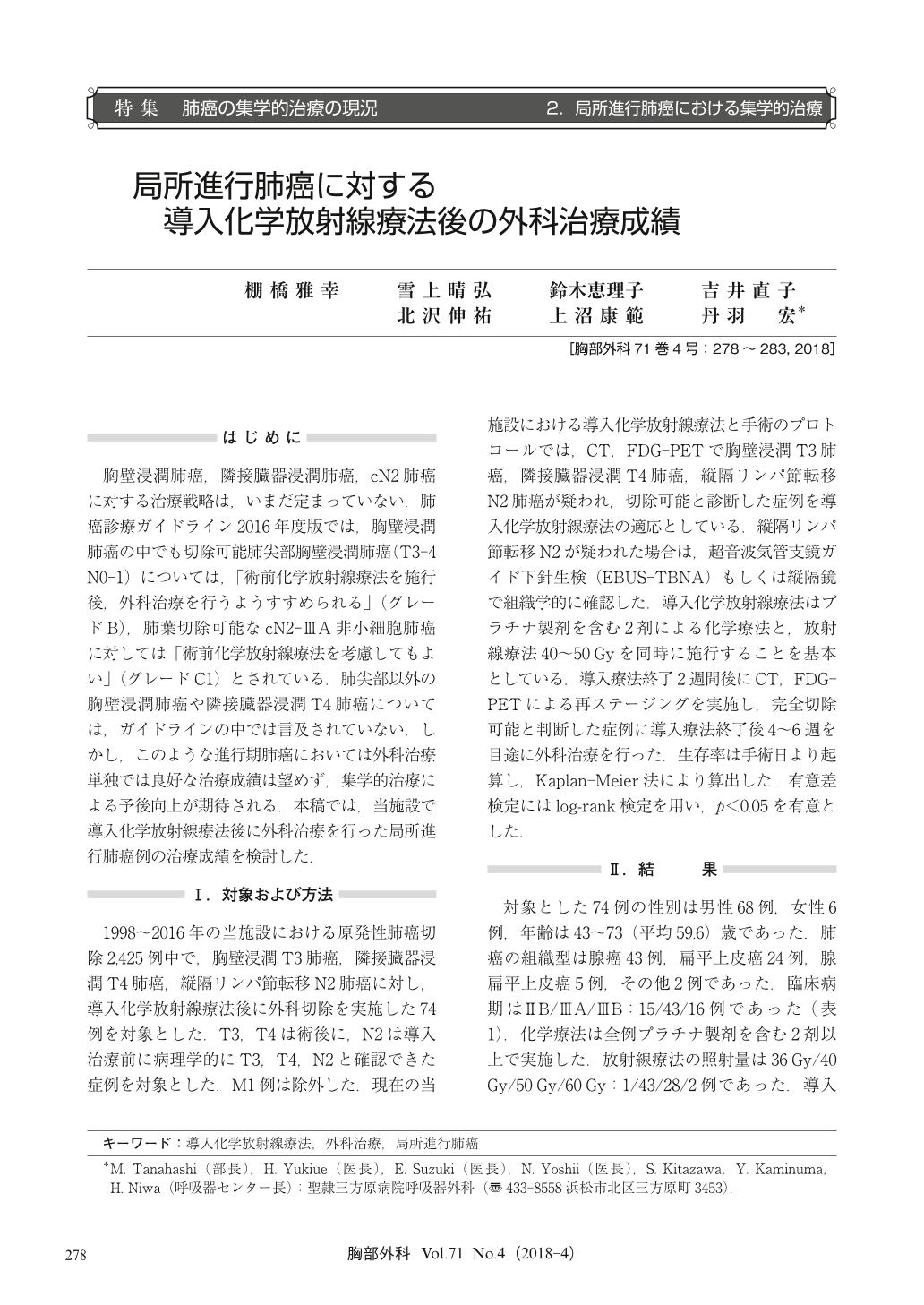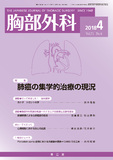Japanese
English
- 有料閲覧
- Abstract 文献概要
- 1ページ目 Look Inside
- 参考文献 Reference
胸壁浸潤肺癌,隣接臓器浸潤肺癌,cN2肺癌に対する治療戦略は,いまだ定まっていない.肺癌診療ガイドライン2016年度版では,胸壁浸潤肺癌の中でも切除可能肺尖部胸壁浸潤肺癌(T3-4N0-1)については,「術前化学放射線療法を施行後,外科治療を行うようすすめられる」(グレードB),肺葉切除可能なcN2-ⅢA非小細胞肺癌に対しては「術前化学放射線療法を考慮してもよい」(グレードC1)とされている.肺尖
Objective:The outcome of surgical treatment of non-small-cell lung cancer after induction chemo-radiotherapy was investigated.
Subjects:The subjects were 74 patients with non-small-cell lung cancer who received induction chemoradiotherapy (ICRT) between 1998 and 2016. ICRT was administered to pT3 lung cancer invading the chest wall(20 patients), pT4 lung cancer invading the adjacent organ(22 patients), and cN2 lung cancer(32 patients). cN2 was confirmed by mediastinoscopy(13 patients) and endobronchial ultrasound-guided transbronchial needle aspiration(EBUS-TBNA)(19 patients).
Results:Sixty-eight and 6 patients were male and female, respectively, and the mean age was 59.6 years old. The histologic type was adenocarcinoma in 43 patients, squamous cell carcinoma in 24, adenosquamous carcinoma in 5, and others in 2. In chemotherapy, 2 or more anticancer drugs including platinum agent were administered. The radiation dosage was 36 Gy in 1 patient, 40 Gy in 43, 50 Gy in 28, and 60 Gy in 2. The effect of ICRT was complete response (CR) in 1 patient, partial response (PR) in 40, and stable disease (SD) in 33 (CR+PR:55.4%). The surgical procedure was lobectomy in 60 patients, pneumonectomy in 10, bilobectomy in 3, and segmentectomy in 1. Tracheobronchoplasty was performed in 9 patients, and combined resection of the vertebral body, left atrium, carina, superior vena cava, aorta, and brachiocephalic subclavian artery was performed in 7, 5, 4, 3, 3, and 3 patients, respectively. Regarding postoperative complications, empyema developed in 5 patients, acute respiratory distress syndrome(ARDS)in 3, pneumonia in 3, tracheobronchial dehiscence in 2, postoperative hemorrhage in 1, atrial fibrillation in 1, and others in 5. Postoperative complication rate was 27.0%, and operative death occurred due to postoperative hemorrhage in 1 patient. Complete resection was achieved in 69 patients(93.2%). Regarding the histological effect of ICRT, Ef.1/2/3 = 32/28/14(Ef.2-3:56.7%), and down stage was achieved in 24 patients (32.4%). The 5-year survival rate of all 74 patients was 51.0%, median survival time (MST)was 62.7 months, and the recurrence-free survival rate was 47.3%. Recurrence occurred in 28 patients (40.6%)with complete resection and the recurrence was distant metastasis in 20 of them. Regarding the outcome by the effect of ICRT, the 5-year survival rates of patients who achieved CR+PR/SD, Ef.2-3/Ef.0-1, and down stage/non-down stage were 66.0%/34.3%(p=0.009), 73.2%/20.1%(p=0.001), and 83.7%/44.0%(p=0.02), respectively, showing that the outcomes of patients who achieved CR/PR, Ef.2-3, and down stage were significantly favorable.
Conclusion:The morbidity and mortality rates of patients who underwent surgery after ICRT were 27 and 1.4%, respectively. More than half of the patients achieved CR-PR and Ef.2-3, 1/3 of the cases were down staged, and the outcomes of these patients were significantly favorable. Surgery after ICRT may improve the treatment outcome of patients with locally advanced lung cancer.

© Nankodo Co., Ltd., 2018


